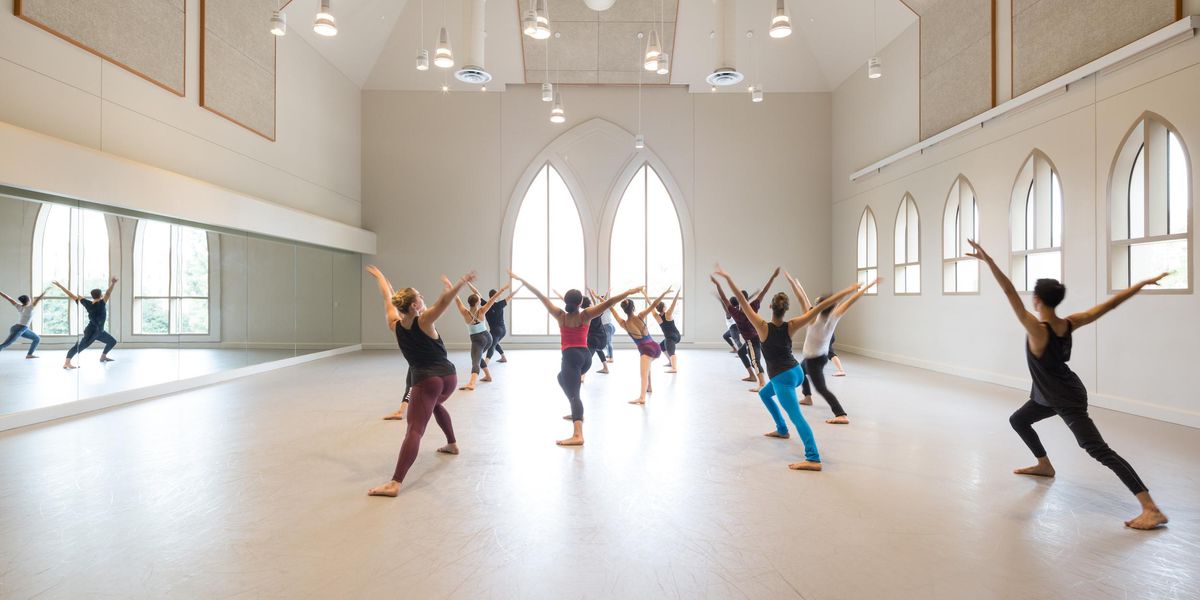Not Your Average Fourth Wall
Feore oversees a rehearsal. All photos by Terry Manzo, Courtesy Stratford Festival.
Despite all her theater experience, dancer Kimberley Rampersad was feeling somewhat disoriented in February, when she began rehearsing Crazy for You. Director/choreographer Donna Feore and her staff kept moving around the room instead of planting themselves in the front. Two weeks into the process the mirrors disappeared. And the choreography seemed very short on straight lines. Rampersad says she couldn’t quite wrap her mind around what was going on. “Then,” she recalls, “you walk into the space, and you’re like, ‘Of course!’ ”
“The space” is the Festival Theatre in Stratford, Ontario—1,800 seats arrayed on three sides of its famous thrust stage. Built in 1957 to house Shakespeare, the theater has often been redeployed for Broadway musicals. Crazy for You, with its Gershwin score, screwball east-meets-west plot, and Feore’s exuberant, showstopping dances, has been a hit, extended into October. Now in her 20th season at the annual Stratford Festival, Feore is an outspoken fan of the stage, having worked there first as a performer. Early assignments choreographing Shakespeare were crucial learning experiences. “Choreography isn’t just about steps,” she says. “It’s about the storytelling. You have to tell people where to look.” The thrust is “a bonus for choreography,” she says, but it took her years to learn that.
For Stratford first-timers like Rampersad, it is daunting. Her dance training, which began in her hometown of Winnipeg, “conditioned” her, she says, “to feel that downstage center is the glory spot. When you get on a thrust stage, you realize that that is not necessarily the case. Upstage center is the strongest.” Feore is accustomed to watching newbies adjust. “They get on that stage and they go, ‘Oh, my God!’ ” she says. “Because you’re not working linear. You’re working in-the-round. You can’t do proscenium choreography.”
Feore’s dance career began in Vancouver, on prosceniums. But after performing with several of Western Canada’s ballet companies, she says, “I took my bunhead to L.A. for three years.” Her film experience helped her deal with Stratford’s thrust, she says. “I work three-dimensionally. Let’s say I want a guy to do a round of back handsprings, or tours jetés coming across. I’ll work the extreme diagonal, never side to side. That way the entire house gets something. There is no master shot.” Rampersad, who has also done film, agrees that dancing on the thrust “feels much more filmic, because point of view becomes so much more dynamic.”
A chorus line becomes “a chorus semi-circle,” laughs the Crazy for You dance captain, Stephen Cota. This is his ninth time at the Festival (which does hire some Americans), and he’s internalized the requirements of the thrust. For example, he says, “You can’t get too close to someone else—intimacy is a little further apart. If you’re within one or two feet of each other, you have to be kissing. Otherwise, you cancel each other out.”
That doesn’t limit Feore’s choreography. “I want people to move at full speed, at full range of motion,” she notes. “So I will strategically take people out of things. I do a lot of two people dance, five people dance. And then I’ll pop in 28 people…doing the same thing at the same time.” For the number “Slap That Bass,” Feore created almost nine minutes of raucous Lindy hop. The stage explodes with flailing arms and legs. “It has to be really carefully choreographed,” she says. “The biggest danger on that stage is elbows. You hire a dancer who’s worked on a thrust stage, they will never intrude on people’s space.”
Although the end result is a kind of stereophonic dance, she teaches most of the choreography facing front. Once onstage, she tells her dancers, “You will face your front—which could be facing aisle nine, which is extreme side.” On the thrust, she adds, “You can stand directly behind somebody and still be seen.” As Rampersad says, “There is no back row.” Cota’s version: “There is no place to hide.”
From Backstage
Dance ensemble:
22
Dance captain:
Stephen Cota, a Feore regular
Associate choreographer:
Kerry Gage, another regular. “She has a huge tap background,” says Feore, “so she can really go after vocabulary and clean and fix and tighten and get more intricate.”
Specialties:
Charleston, Lindy hop, tap. “But my background is ballet,” Feore says, “so I always go for a technical dancer. In auditions, I do a ballet combo right off the bat, even if I’m not doing ballet in the show. In this case, I needed girls who weren’t afraid to go up in the air. I was asking a lot more from the dancers. So this was really hard to cast; it took five months.”




